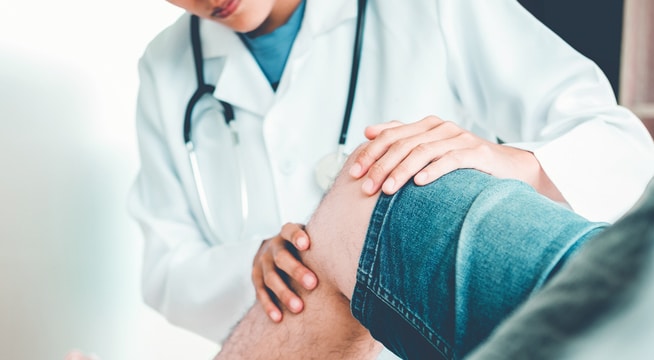MCL Tears: Symptoms, Causes, Treatment & More
Sprains & Tears
•
Dec 19, 2018
Reviewed by:

Healthy knees are essential to do most activities: From getting out of bed, to walking to the shower, going up and down stairs, and getting most of your daily activities done. If you’re an athlete, you’re even more hyper-aware of the need to have healthy knee joints. Because there’s nothing that adds more frustration around an injury than being told that you can’t participate in your favorite sport.
Yet, getting injured may sometimes be inevitable. In order to receive proper care, it’s good to have a basic knowledge of common knee injuries, such as an MCL tear.
What is an MCL tear?
Joints are held in place by soft tissue called ligaments. The knee joint is composed of the bottom part of the femur (the thigh bone), the patella (the kneecap), and the top portion of the tibia (shin bone).
The Medial Collateral Ligament (MCL) is located on the inner side of your knees. Whenever a person suffers from a rupture in the MCL, the injury is known as an MCL tear.
Types of MCL Injuries
There are three types of MCL injuries:
Grade 1 MCL Injury
This is the mildest form of an MCL tear. You may experience minor pain and tenderness on the inside of your knee.
Grade 2 MCL Injury
When you have a grade 2 MCL injury, you’ll feel strong pain and experience swelling.
Grade 3 MCL Injury
This is the most severe type of MCL tear. The most common symptoms are significant pain and knee instability.
Symptoms of MCL Injuries
When a person has an MCL tear, they’ll experience some or all of the following symptoms:
- Hear a popping sound as the ligament ruptures
- Pain when putting weight on the knee, especially on the inner side of the joint.
- The injured knee gives out
- Instability of the knee joint
Causes and Risk Factors of MCL Injuries
MCL tears are caused by trauma to the outside of the knee, usually from a fall, an accident, or a hard hit suffered while playing sports.
It’s most likely to happen to people who play contact sports, such as:
- Football
- Hockey
- Lacrosse
- Rugby
- Wrestling
Diagnosis and Treatment For MCL Injuries
When you go to the doctor, she or he will apply pressure along the inside of your knees to check for pain and/or tenderness. Your medical provider may also order x-rays or an MRI to verify whether there are any additional injuries to the bone.
Most MCL tears heal on their own. To ensure a full recovery, we recommend using the RICE Method: rest, icing the injury, compression, and elevation. Depending on the type of injury, your doctor may also recommend physical therapy and/or wearing a protective knee brace. Always seek a medical opinion to avoid further injury.
Although surgery is sometimes required, those instances are very rare.
MCL Injury Prevention
While some injuries are unavoidable, you can lower your risk of suffering from an MCL tear by doing regular strength training exercises for your hip and leg muscles. You should also wear protective gear when playing contact sports, and be mindful of preventing falls.
24-Hour Emergency Room Services in Colorado Springs and Texas
If you think you might have an MCL injury, we can provide you with the care you need. If you have questions or need immediate treatment, your nearest Complete Care location is ready to help, no matter the time of day or night. We offer a variety of services to help you and your family in your time of need. No appointments are necessary.
Find the Complete Care location nearest you.
